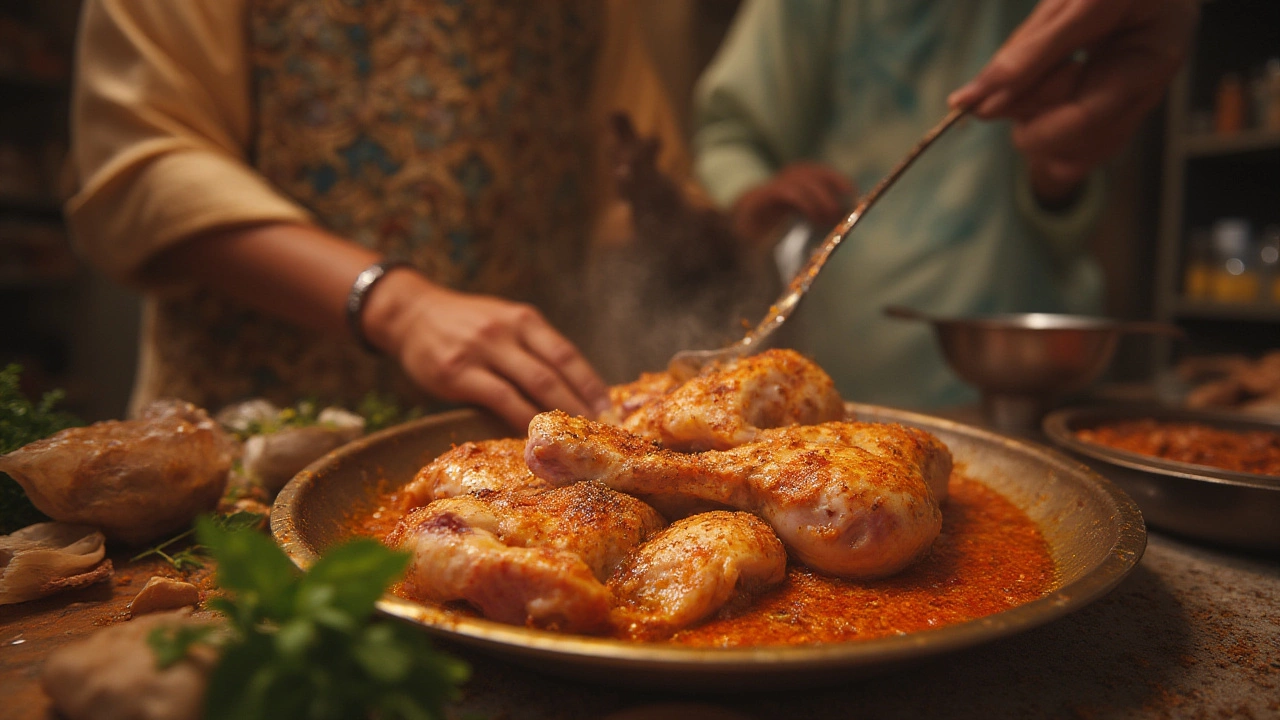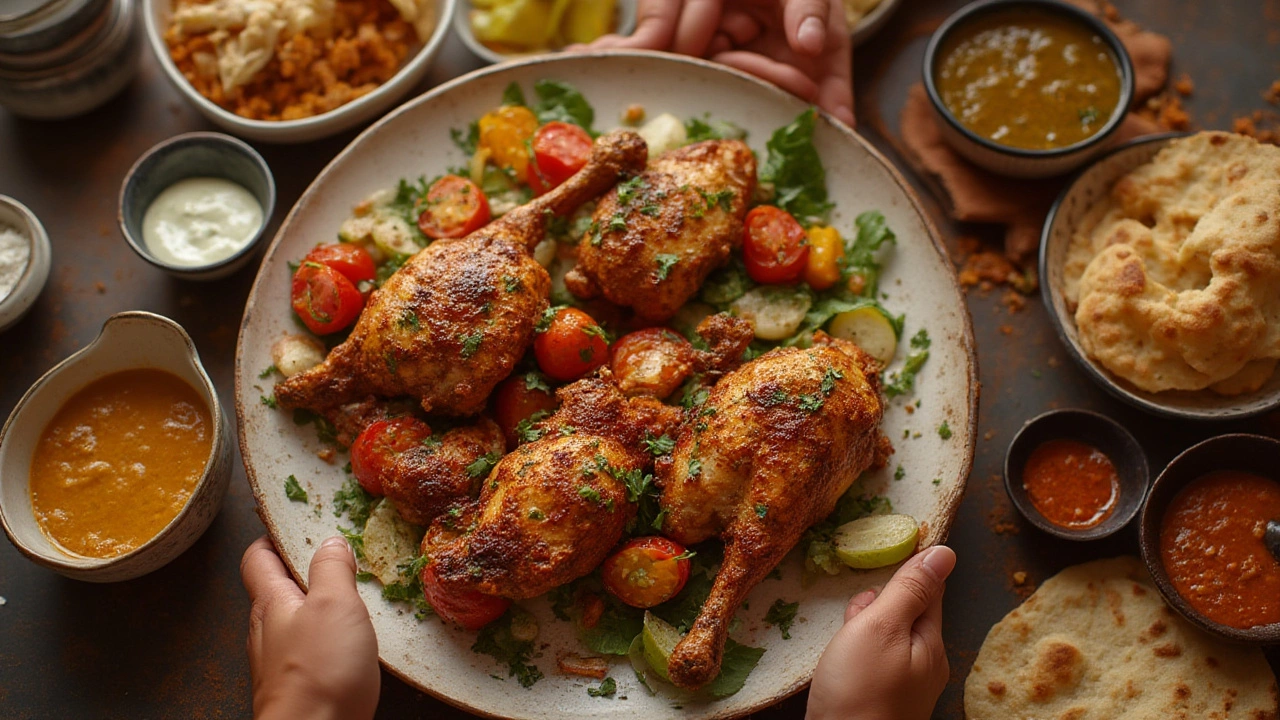Tandoori Chicken Dryness Explained: Causes, Fixes, and Tasty Secrets
 Jul, 12 2025
Jul, 12 2025
Bite into tandoori chicken at most restaurants, and your jaw gets a workout—and not the good kind. So many promise succulent, smoky perfection, but you get shoe leather. Sometimes it feels like the whole world’s obsessed with this bright-red dish, but no one dares whisper the main complaint: it’s often way too dry. Ever wondered why this happens so much, even among passionate cooks who truly love their chicken? Digging into what goes wrong (and how to fix it) is like shining a flashlight on a big, tasty mystery.
The Tandoori Chicken Origin Story—and Why It’s Supposed to Be Juicy
If you asked someone in Delhi or Lahore to describe tandoori chicken, you’d hear about its smoky char, its mind-blowing aroma, and—most of all—how juicy it’s supposed to be. But this dish wasn’t invented to dry your mouth out. Tandoori chicken burst onto the scene in the 1940s at Moti Mahal restaurant in Delhi—born from the marriage of yogurt-marinated chicken and the scorching clay oven called a tandoor. Originally, butterflied chickens got a spicy yogurt bath, then landed inside a tandoor burning red-hot with coals that could hit 480°C (900ºF). Because the chicken roasted fast—think 10–15 minutes—it barely had time to dry out.
People forget that tandoori chicken only works when roasting meets moisture. Traditional recipes call for bone-in thighs and legs for a reason: these stay juicy under high heat. The classic yogurt marinade, loaded with ginger, garlic, lemon juice, chili, and spices, helps tenderize and lock in moisture. So where’s the disconnect? Why do modern kitchens and even restaurants get it so wrong?
What Dries Out Tandoori Chicken? The Science and the Slip-Ups
This dish isn’t supposed to be jerky. So what’s going on? The first culprit: the chicken. Restaurants aiming for speed or cheaper costs often use skinless, boneless chicken breasts. Sure, they marinate it, but breasts have less fat and are known for drying fast. When exposed to dry heat, breast meat turns tough before it develops flavor.
The second problem: not enough marination time. Real cooks know you need at least six hours—ideally overnight—so the lactic acid in yogurt and lemon juice actually breaks down protein fibers. Rushed chicken never gets tender.
Then there’s the big elephant: modern ovens. Most home cooks don’t have access to a tandoor’s insane heat and humidity. Your kitchen oven, maxed out at 250°C (475°F), just can’t deliver the same kick. Plus, convection ovens blast hot air that steals moisture.
And don’t forget overcooking. Social media is full of tandoori cooks swearing by longer cook times to mimic ‘restaurant flavor.’ That’s a ticket to dryness. Because chicken (especially thighs or legs) tastes best at 74°C (165°F)—let it run too far over, and you’re done. Even five minutes too long can dry the meat out.
| Dryness Factor | Traditional (Tandoor) | Common Error |
|---|---|---|
| Chicken Cut | Bone-in Thigh/Leg | Breast, Boneless |
| Marination | 8-12 hours | 1-2 hours |
| Cooking Heat | 450–900ºF (High, moist) | 300–475ºF (Lower, dry) |
| Cooking Time | 10–15 min | Too long (20+ min) |

Marinade Magic: How Yogurt and Spices Fight Dryness
The secret armor of tandoori chicken is marinade. Talk to any Indian grandma, and she’ll tell you the right marinade isn’t just about taste—it’s your best defense against dry meat. Yogurt does the heavy lifting because its lactic acid and calcium gently unravel tough muscle fibers. This creates tiny gaps in the protein, holding in liquid even at high heat. Lemon juice and vinegar? They help, but only a little. Overdo the acid, though, and your chicken gets rubbery.
Ginger and garlic paste, a non-negotiable in Indian kitchens, brings enzymes that naturally tenderize meat. Salt and spices not only add flavor—they start breaking down cells while chicken soaks. Kashmiri chili powder gives you color without overpowering heat, so the outside doesn’t burn before the inside is ready.
Here’s something worth remembering: the longer you marinate, the silkier the chicken gets. Most home cooks give tandoori only an hour or two, but a real transformation happens after at least eight hours. Put the marinade straight on deep cuts you’ve slashed through the meat (but not all the way through or you’ll end up with strips, not chicken pieces!). That’s how flavor soaks deep and holds moisture.
If you’re using store-bought yogurt, strain it so it’s not watery. Excess water kills the adhesive power of the spices—your chicken sweats out liquid and dries up instead of self-basting as it cooks. Many pros add a big tablespoon of cream or even a teaspoon of oil to add fat, which creates a safety net for juiciness.
Heat, Humidity, and the Tandoor Illusion at Home
Cooking tandoori chicken in a real tandoor is almost cheating because the clay oven does two things at once: it forces high heat from scorching coals, and it surrounds the meat with a cloud of sopping wet air. The tandoor walls suck up marinade drips and then pump vapor back into your chicken. That’s nearly impossible to replicate in a home oven—unless you get creative.
If you want juicy tandoori at home, try this: get your oven screaming hot (like, preheat at max temperature for 30 minutes before you even put the chicken in). Use the broiler for the last five minutes to char the edges but not so close that it scorches. Another move? Place a tray of water at the bottom rack for humidity. This tiny trick keeps the inside of the meat moist while the outside gets smoky.
Grill lovers get similar results. Fire up all burners, create an indirect heat zone, and keep the lid shut most of the time. Meat thermometers are your friend here. Pull chicken at 72–73°C (162–163°F), let it rest, and it’ll finish on the counter. Don’t poke or cut too early, or you’ll lose precious juice. And please, don’t press it down with a spatula—let those juices stay inside.
Want smoke? Try the restaurant hack—burn a chunk of charcoal, drop it on a foil cup inside a bowl of just-cooked chicken, add a splash of ghee, cover with a tight lid for three minutes. That tandoor aroma comes alive at home!

How to Make Tandoori Chicken That’s Never Dry: Step-By-Step Tips from Real Cooks
If you want to level up your tandoori game, here’s a tried-and-tested step-by-step. Real Indian restaurant cooks and serious home chefs swear by these:
- Pick the right cut: Forget chicken breast; use bone-in thighs or drumsticks. They hold more fat and moisture.
- Score the meat: Make 2-3 deep slashes in every piece so the marinade soaks deep, not just the surface. But don’t cut right through. Those cuts help heat reach the bone so everything cooks evenly.
- Use a full-fat, strained yogurt marinade: Add ginger-garlic paste, 2 tsp lemon juice, 1 tbsp cream, salt, cumin powder, Kashmiri chili powder, turmeric, a splash of oil, plus garam masala. Marinate at least 8–12 hours. Yes, you need patience.
- Let the chicken come to room temp before cooking: Cold chicken releases more water when cooked, leading to dry results. Take it out of the fridge an hour before.
- High-heat blitz: Cook at max oven temp, ideally with broiler on for last few minutes for char. Time depends on thickness, but 20 minutes is usually more than enough for thighs.
- Add humidity: Set a tray of water in the oven. On grill, loosely tent foil for part of the cook, then open to crisp up.
- Rest the meat: Always let chicken rest for 5 minutes before slicing. This lets juices settle back inside.
- Optional smoky finish: Charcoal smoke ‘dhungar’—the burnt coal and ghee trick—gives home tandoori that true restaurant aroma.
Want a cheat code if you’re short on time? Brine your chicken before marinating. Just soak in 1/4 cup salt to 2 liters water for an hour, then pat dry before adding yogurt marinade. Brining helps the chicken retain liquid when it hits the heat.
